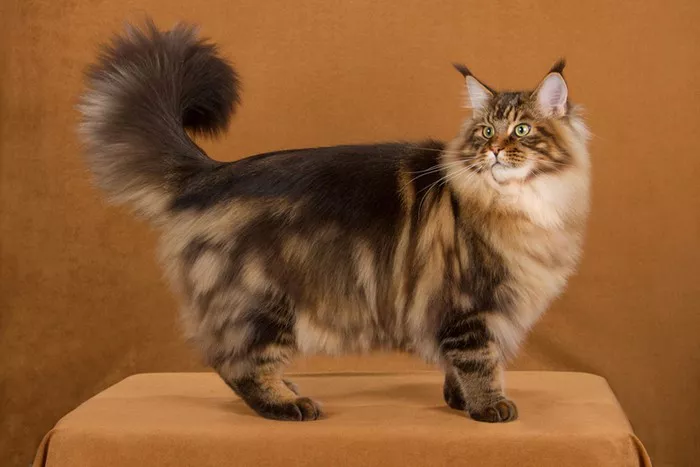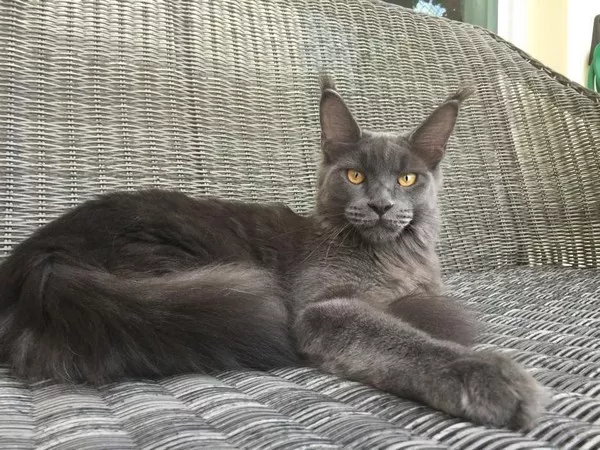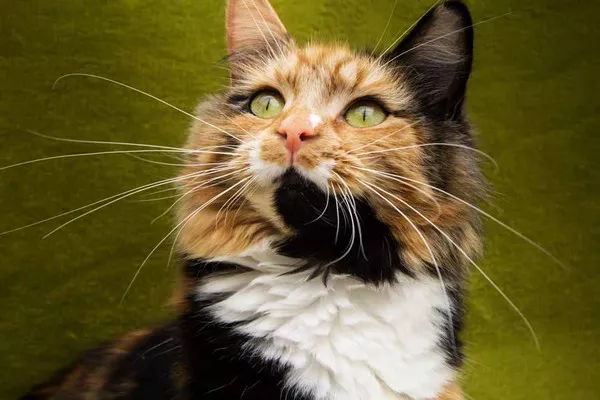The Maine Coon cat, often touted as one of the largest and most majestic domestic cat breeds, has long captured the fascination of cat enthusiasts worldwide. With its tufted ears, bushy tail, and impressive size, the Maine Coon’s appearance has led to various speculations about its origin, including the persistent myth that it is part raccoon. In this article, we will delve into the history and characteristics of the Maine Coon, dispel the myth of its alleged raccoon ancestry, and explore the real origins that make this breed unique.
The Maine Coon’s Distinctive Features
1. Large Size and Sturdy Build: One of the most notable characteristics of the Maine Coon cat is its substantial size. Adult Maine Coons are often larger than the average domestic cat, with males weighing between 13-18 pounds and females between 8-12 pounds. This robust build contributes to the breed’s impressive appearance.
2. Tufted Ears: Maine Coon cats are recognized for their tufted ears, featuring lynx-like tips. These ear tufts add to their regal and wildcat-like appearance, sparking speculation about their potential connection to other wild animals such as raccoons.
3. Bushy Tail: The Maine Coon’s tail is another distinctive feature. Long and bushy, the tail adds to the breed’s overall elegance. Some observers have drawn parallels between the Maine Coon’s tail and that of a raccoon, further fueling the myth of their shared ancestry.
4. Friendly and Sociable Nature: Despite their imposing size and wildcat-like appearance, Maine Coon cats are known for their friendly and sociable nature. They often form strong bonds with their human companions and get along well with children and other pets. This temperament contrasts with the elusive and independent behavior of raccoons.
The Myth of Maine Coon Cats Being Part Raccoon
1. Origins of the Myth: The myth of Maine Coon cats being part raccoon likely stems from the breed’s physical features, particularly their tufted ears and bushy tails, which some people may associate with raccoons. Additionally, the tufted ears and large size may have led to the erroneous belief that there was a genetic connection between Maine Coons and raccoons.
2. Genetic Improbability: Biologically, the idea of a domestic cat being part raccoon is implausible. Cats and raccoons belong to different animal families, with distinct genetic makeup and characteristics. Crossbreeding between these two species is not only improbable but genetically impossible due to their differing chromosome numbers.
3. Evolutionary Background: The Maine Coon’s history can be traced back to the northeastern United States, particularly the state of Maine, where the breed is believed to have originated. There is no historical evidence or scientific basis to support the notion that Maine Coon cats share a common ancestry with raccoons.
The True Origins of the Maine Coon
1. American Heritage: The Maine Coon is an American breed with a rich history that dates back to the early days of the United States. While the exact origins are not well-documented, several theories attempt to explain the breed’s development.
2. Seafaring Legends: One popular legend suggests that Maine Coon cats are descendants of long-haired cats brought to the United States by seafarers and traders. These cats may have interbred with local cats, resulting in a breed uniquely adapted to the harsh climate of the northeastern regions.
3. Natural Selection: The Maine Coon’s physical characteristics, such as its large size, tufted ears, and bushy tail, are believed to be adaptations that helped the breed survive in the rugged landscapes of Maine. These features likely evolved through natural selection to provide advantages in hunting, climbing, and navigating challenging terrain.
4. Contributions from Other Breeds: While the Maine Coon’s exact lineage is unclear, it is likely that the breed’s development involved contributions from various long-haired cats brought to the region over the years. Some believe that Persian, Angora, or even Norwegian Forest Cats may have played a role in shaping the Maine Coon’s distinctive features.
Debunking Physical Similarities
1. Tufted Ears: The tufted ears of Maine Coon cats, while visually reminiscent of some wildcats, are not exclusive to raccoons. Many cat breeds, including the Scottish Fold and American Curl, exhibit ear tufts, and this trait is a result of genetic variation within domestic cat populations.
2. Bushy Tails: The bushy tails of Maine Coon cats, often cited as evidence of their raccoon ancestry, are a characteristic shared by various cat breeds. Long, bushy tails are common in many domestic cats and are not exclusive to raccoons.
3. Facial Features: Despite occasional claims of facial similarities, the facial structure of Maine Coon cats is fundamentally different from that of raccoons. The Maine Coon’s facial anatomy aligns with typical domestic cat characteristics, with a short nose and almond-shaped eyes.
4. Genetic Diversity: The physical traits of Maine Coon cats are the result of genetic diversity within the breed, shaped by selective breeding practices over time. These traits do not indicate a genetic relationship with raccoons but rather highlight the breed’s unique adaptations and development.
Maine Coon Cats as Domestic Companions
1. Gentle Giants: Maine Coon cats are often referred to as “gentle giants” due to their large size and amiable nature. Despite their imposing appearance, they are known for being affectionate, sociable, and well-suited to indoor living.
2. Compatibility with Families: The friendly temperament of Maine Coon cats makes them excellent companions for families with children and other pets. Their sociable nature and adaptability contribute to their popularity as beloved household members.
3. Adaptation to Indoor Living: While Maine Coon cats may have evolved in outdoor environments, they adapt well to indoor living. Their sociability and need for human interaction make them well-suited for households where they can engage in daily activities with their owners.
4. Vocal Communication: Maine Coon cats are known for their distinctive vocalizations. They may “chirp,” trill, or produce a wide range of melodic sounds to communicate with their owners. This vocal trait is unrelated to raccoon vocalizations but adds to the unique charm of the breed.
Conclusion
In conclusion, the myth of Maine Coon cats being part raccoon is rooted in misconceptions about the breed’s physical features and an inaccurate understanding of genetics. The Maine Coon is a purely domestic cat breed with a fascinating history shaped by its adaptation to the northeastern United States. The breed’s tufted ears, bushy tail, and large size are the result of natural selection, genetic diversity, and selective breeding practices.
Debunking the myth of raccoon ancestry highlights the importance of accurate information about cat breeds and their unique characteristics. Maine Coon cats, with their gentle nature and captivating appearance, have rightfully earned their place as beloved domestic companions, free from any genetic connection to raccoons. Understanding and appreciating the true origins of the Maine Coon adds depth to the appreciation of this remarkable feline breed.
























